Brief: It’s FOSS reader Dave Merritt shares some hidden and ignored features of Linux Mint Cinnamon that he started to love.
I’m often asked by traumatized Windows users which Linux operating system I would recommend. Until a year and a half ago I recommended Zorin OS without hesitation. However, last year at this time, Zorin was still working on a major re-write and could not offer an LTS (long-term support) release.
One of the problems of the Linux world is that distros great and small come and go. So lacking any certainty that Zorin would be ready before my version lost its support—or that Zorin would still exist—I downloaded Linux Mint Cinnamon 18 and have been using and recommending it ever since.
5 features of Linux Mint I love

As a result, the last 18 months have been quite boring for me: nothing ever seems to go wrong with Linux Mint. On the other hand, it’s nice to write about things that work well. For this article, I’ll focus on five tiny and easy-to-use features that I’ve found to be very useful. All come pre-installed. Which is nice since using Synaptic Package Manager or the bash line can be quite intimidating for newcomers to Linux.
1. Nemo Preview
I have a large music collection and often make compilation CDs for friends. If you’ve done this yourself, you’ve probably noticed that “gain” varies greatly from CD to CD and from format to format. And while Brasero and most other burning apps can smooth out small bumps it can’t do much about the more wild inconsistencies that often show up. And while the gain on a single track is easily adjusted using Audacity, it’s hard to tell how much adjustment is needed if you can’t quickly compare it to a benchmark file.
Say you’re at the point where if two tracks can be made to match, the disc will be perfect. My problem here is that my default music player, Banshee, has to suck up hundreds of albums from an external drive before it will open and that takes a few seconds. And once up it can take a few more seconds to switch back and forth from track to track. Full-featured music players simply aren’t designed to be nimble.
This is where Nemo Preview comes in. It’s built into the Nemo File Manager and couldn’t be faster or easier to use. Simply click on the file and hit “space bar”. If it’s an audio file, a micro player appears and starts playing instantly. Hit “space bar” again to close it, click on the new file and hit “space bar” again, and you’re listening to the other track. Nemo Preview also works on most other types of files, though not always with the same blazing speed.
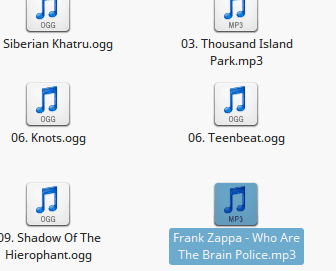
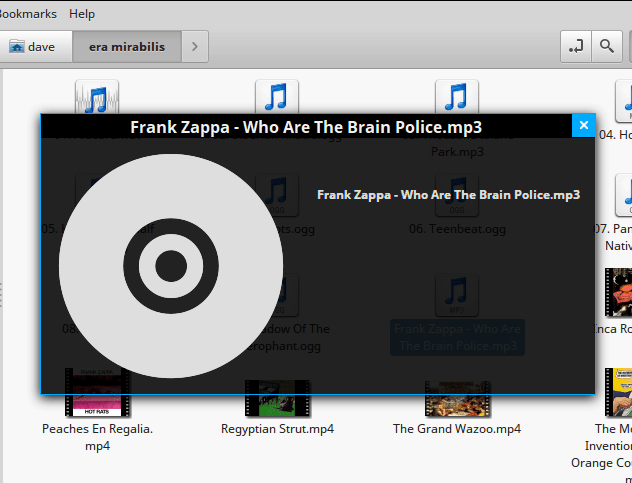
2. Mint Menu Part 1 The “Uninstall” Feature
A few weeks ago I was trying to make a Skype call, but Skype wouldn’t open. This wasn’t the first time this has happened to me. It happens every time Skype upgrades. Microsoft makes an upgraded version for Linux but makes no allowances for the removal of the newly defunct version. Trying to install a current version isn’t all that hard; the latest version is present in the Mint repositories and its easy enough to down a .deb file from the Skype website. But if you forget to remove the old version first, you can wind up with two versions—only one of which works.
For an experienced user, this can be easily solved two different ways. The redundant version can be removed using Synaptic Package Manager, or by opening
Software Manager, clicking on “show installed applications”, hunting it down and then removing it by clicking “uninstall”.
However, the Mint Menu offers a far simpler solution. Locate the application and “Right-click” on the icon. This activates a drop menu—which also allows you to create a panel or desktop launchers. Click on “Uninstall” from the drop menu. This activates Synaptic, prompting you to type in your password. Finally, a progress window will open, which will tell you when it’s done (or will sometimes ask to allow certain other libraries to be added or removed).
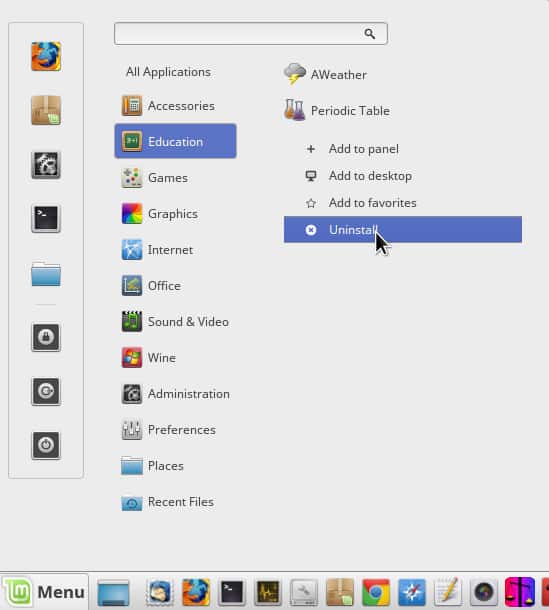
So, returning to the redundant Skype problem, since both versions will appear in the menu, simply test and then “Uninstall” the one that doesn’t work.
[irp posts=”26695″ name=”Linux Mint 19 Release Date and New Features”]
3. Mint Menu Part 2 Where the heck did that Download Go? Use “Recent Files” to find out!
Like every Linux OS I’ve ever used, Mint Menu has a “Recent Files” option. This option remembers not only files you’ve created or used but also everything you’ve downloaded. A mistake I frequently make is addressing a download to the wrong folder. Nemo has a decent search function but it can take time. It’s far easier to find a file’s location in the Mint Menu. Click on “Recent Files”, hover over the misplaced file and at the bottom of the menu it’s exact location will appear.
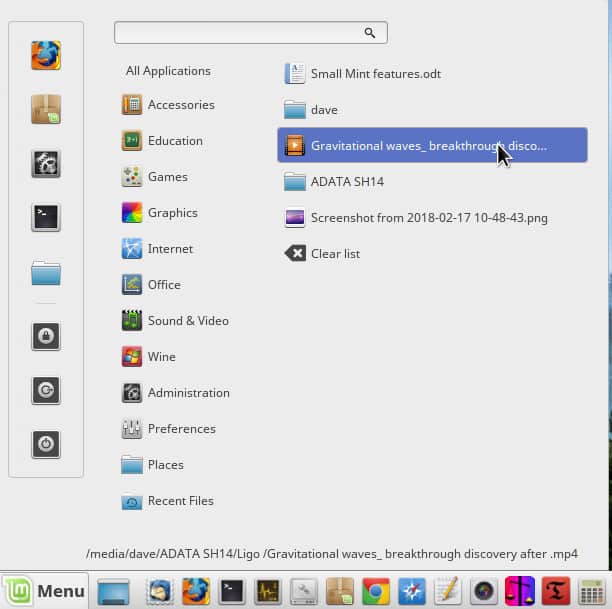
If the “Recent Files” option doesn’t appear in your menu, that’s because there is an option to turn it off in order to protect your computing activities from prying eyes. If you can’t find it on your menu, go to “System Settings” and click “Privacy”. You’ll see this screen:
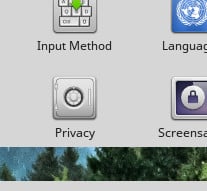
Simply toggle it to “on” and adjust further as suits your needs. (But remember, if you select “Never forget old files” your menu will take longer and longer to open as time passes and entries multiply.)

4. Unattended Upgrade: An invisible friend
For at least a decade I’ve been an occasional user of “ClamAV”. It’s an open source virus scanner for Linux. When I use it, it’s as a courtesy: Linux systems may be immune to all known Windows viruses, but Linux users can pass them on to systems which are not.
Anti-virus software has unique needs: writers of malicious code don’t release their work on a predictable schedule. So virus signatures are ever-changing. And furthermore, the more creative mal-ware becomes, the more creative search algorithms need to be.
But even though ClamAV can be downloaded from most repositories, that was pretty much it. If you wanted to use you had to manually update first the engines, and then the virus signatures—and in that order, if you wanted it to work properly. Since these updates came directly from the author’s servers, this process could take a lot of time.
While this was a hassle, it usually worked—eventually. And I can understand why virus signatures should be updated manually with every use—it would place an absurd burden on the repositories to keep them current. But what I could never understand why the repositories never sent updates for the interface. In a decade of using ClamAV on Ubuntu, Fedora and Zorin I never received a single update.
I’m the sort of nosey-parker who examines every update that comes my way. One of the features of the Mint “Update Manager” is that it provides a description of the item as well as a change log. Soon after switching to Mint, one of the updates I got was called “unattended upgrades”. Oddly it lacked any such information. That’s because “Unattended Upgrades” (along with “Mint upgrade” which I plan to examine more thoroughly in the future) isn’t really a package. What it does is search your system for rarely used packages from official repositories and PPAs to make sure even low priority applications are checked for updates instead of—as usual—being ignored.
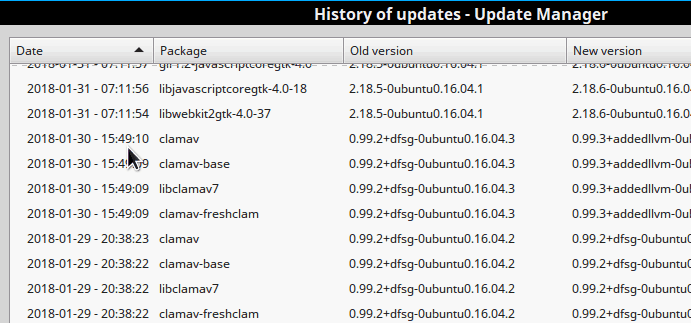
Soon after I received for the first time ever updates for ClamAV. Above are my most recent updates.
5. Sound Settings
This last built-in feature has little practical value, but it can nevertheless be loads of fun. Most Linux systems come with a limited range of built-in audio files to give you audible cues for various system states; log in, log out or notifications of new emails, for example. Linux Mint Cinnamon has gone to great lengths to offer users the ability to install their own sound scripts and to choose which system events you’d like among them to notify you about. The only limitation is that custom sounds must be in ogg or wav formats. It’s also a good idea to nest them somewhere in your home folder, though not absolutely necessary.
You can find and download system sounds all over the web. But if you’re feeling adventurous you can easily make your own. They can be verbal: simply record your own voice—if you have a webcam you’ve got a microphone. You can also raid your music collection. Using Audacity you can clip out a section of a song, save it as an ogg or wav file and use the “fade in” and fade out” effects to smooth out the edges. Or you can go really crazy and use the wide range of effects. (My favorite is “Paulstretch”.)
Once you’ve made your palette of sounds, installation is a breeze. Go to “System Settings”, scroll down to “Hardware”, click “Sound” and then “Sound Effects”. From this menu, you can add or remove sound effects by toggling them on or off. By choosing the music icon you can plug in your custom sounds and then you can test them with the play icon.

A Few Caveats
The first three features I mentioned were available in Zorin 9, although I couldn’t find them in the first release of Zorin 12, they may have been added since. None of the first three features appear in the latest version Ubuntu Gnome. Finally, for all I know “Unattended Upgrades” is common a feature of all Ubuntu-based Linux Systems these days. But what I can say in total candor is that in over a decade of using Linux I never received a single update for “Grub Customizer” or “Clamav” until I switched to Linux Mint.

Dave Merritt
I’m a 59 years old, fulltime landscaper and parttime PCmedic. I’ve been an avid Linux user for over ten years. In that time, I do not claim to have made every possible mistake, only most of them. I’m a big fan of prog rock, avant jazz and J S Bach, and enjoy reading Neal Stephenson and anything to do with the foundational problems in modern physics.


